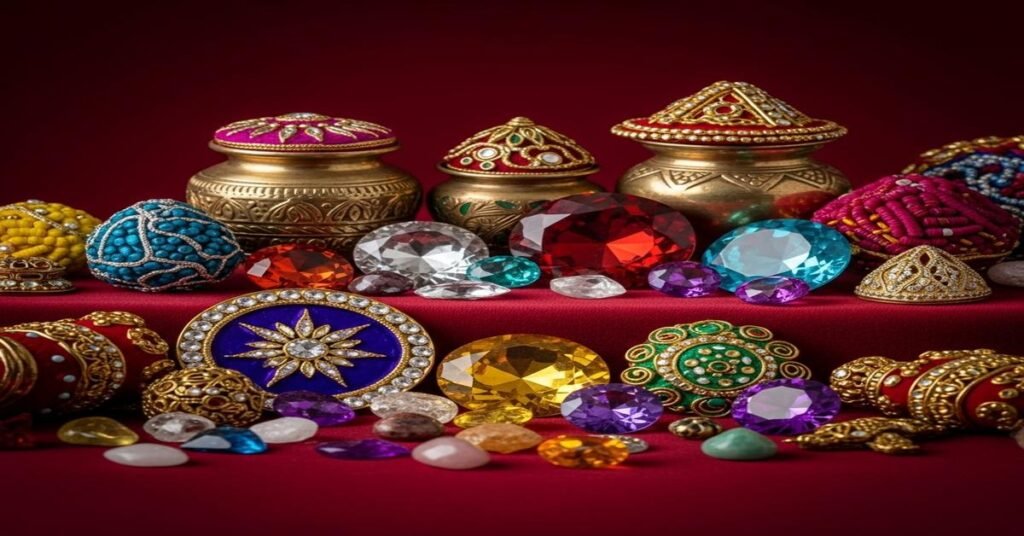Festivals often shape what people wear, buy and gift. Across Asia, specific gemstones and metals carry meaning: protection, prosperity, devotion or family continuity. Knowing the traditions and the practical details — which stone, what purity of gold, typical sizes and how to care for them — helps you choose meaningful pieces that last. Below I explain the common festival-gem links, why they matter, and what to look for when buying or gifting.
Jade and Lunar New Year (and related celebrations)
Jade is the most visible gemstone connected to Lunar New Year, Tet (Vietnam) and Korean Seollal. It symbolizes longevity, luck and protection. There are two minerals called jade: jadeite and nephrite. Jadeite, especially translucent green “imperial” jadeite, is the highest value.
Practical details:
- Common items: bangles, pendants, carved amulets.
- Bangle sizes: inner diameter typically 54–62 mm; thickness 6–10 mm. Choose a snug fit but not tight — jade is brittle and a tight bangle can break if struck.
- Weight/measurement: jade is often sold by gram rather than carat. A solid bangle usually weighs 40–80 g depending on size and thickness.
- Quality cues: look for translucency and even color. Beware of dyed or polymer-impregnated jade. Ask for an A/B/C grade description or a laboratory report.
Why jade for the New Year? The green color and hardness convey renewal and resilience. Families exchange jade to wish long life and harmony.
Gold and Lunar New Year / Diwali
Gold is central to both Chinese New Year and Diwali. It signifies wealth and auspiciousness. But purity and workmanship differ by region.
- Indian markets: 22k (91.6% gold) is standard. It’s soft enough for heavy, ornate jewellery like kundan, polki and temple pieces. Typical pendant weights for daily wear: 2–8 g; necklaces and chains range 5–30 g.
- Chinese and Southeast Asian buyers: 24k (99.9%) is preferred for bullion and simple motifs; 18k (75%) is used for modern, finer settings where durability is needed.
- Design cues: Lunar New Year pieces use red and gold motifs, coins, dragons and the character “福”. Diwali designs favor floral, diya (lamp) shapes and intricate enamel (meenakari).
Why gold? Gold is a portable store of value and a culturally accepted gift of blessing. For heavily worn jewellery choose 18k or 22k alloy with appropriate hardness; for investment buy higher purity bullion.
Navaratna, gemstones and Diwali festival uses
Navaratna is a traditional nine-gem arrangement used in Hindu astrology. Each gem corresponds to a celestial body and is worn for balance and protection. Navaratna pieces become popular during Diwali and other religious days.
Navaratna list and practical specs:
- Ruby (Manik) — Sun: 0.10–0.50 ct faceted or small cabochon; set on ring finger for Sun benefits.
- Pearl (Moti) — Moon: 6–10 mm, nacre thickness >0.5 mm preferred; avoid faux pearls for astrology use.
- Red coral (Moonga): 3–7 mm cabochon beads, natural coral preferred.
- Emerald (Panna): 0.25–0.75 ct faceted; expect oiling — ask about treatment.
- Yellow sapphire (Pukhraj): 0.25–1.0 ct for ring; heat-treated is common.
- Diamond (Heera): 0.10–0.50 ct accents are common.
- Blue sapphire (Neelam): 0.25–1.0 ct; quality and treatment matter.
- Hessonite (Gomed): 0.3–1.0 ct cabochon or faceted.
- Cat’s eye (Lehsunia): 0.5–2.0 ct chrysoberyl cabochon with a sharp eye.
Traditional settings use 22k gold or silver. Stones in a Navaratna are usually small (0.1–0.5 ct each) so the piece remains wearable and balanced. People buy Navaratna rings or pendants at Diwali to invite planetary harmony for the coming year.
Other festival-linked gems and regional notes
Across Asia and beyond, other pairings exist:
- Mid-Autumn / Moon festivals: moonstone and pearls for lunar symbolism.
- Holi and spring festivals: colorful enamel and gemstone combinations — tourmaline, topaz and garnet — represent renewal.
- Eid and weddings: diamonds and emeralds are common across South Asia and the Middle East, often set in 22k or 18k gold depending on style.
These choices follow color symbolism: red for luck and energy, green for growth, white for purity. The materials selected are meant to reinforce the festival message.
Buying and care: practical advice
When buying festival jewellery, verify origin, treatment and metal purity. Ask for these documents or tests:
- Metal hallmarks: 22k = 916, 18k = 750, 24k = 999.
- Gem reports: for expensive items (diamonds >0.5 ct, emeralds and jade over certain values) request a lab report on identity and treatment.
- Jade tests: ask whether it’s A (untreated), B (bleached/dyed), or C (dyed) jade. Prefer A for durable heirlooms.
Care tips:
- Cleaning: mild soap and warm water for most pieces. Use a soft brush for settings. Avoid ultrasonic cleaners for emeralds, pearls, opals and heavily treated stones.
- Pearls: wipe after wear to remove acids and oils. Don’t submerge in chemicals or ultrasonic baths.
- Gold: 22k and 24k scratch more easily. Store separately in soft pouches. For 22k, occasional professional polishing restores shine.
- Jade: avoid sudden temperature changes and sharp knocks. Store alone; jade can be brittle despite its toughness.
Gift suggestions by festival
Practical, size-aware picks that respect tradition and daily wear:
- Lunar New Year: jade bangle (inner diameter 56–58 mm, thickness 6–8 mm) or a small 22k gold pendant 2–5 g with auspicious motif.
- Diwali: 22k Navaratna ring (stones ~0.1–0.3 ct each, 2–4 g gold) or diamond studs totaling 0.5–1.0 ct in 18k white gold for daily wear.
- Weddings/family celebrations: heavier 22k chain or temple jewellery 10–30 g depending on budget and wearer’s style.
Choosing festival jewelry is partly about meaning and partly about durability. Match the material and setting to how the piece will be used. Ask about treatments and purity so the gift keeps its value and significance.
I am G S Sachin, a gemologist with a Diploma in Polished Diamond Grading from KGK Academy, Jaipur. I love writing about jewelry, gems, and diamonds, and I share simple, honest reviews and easy buying tips on JewellersReviews.com to help you choose pieces you’ll love with confidence.

